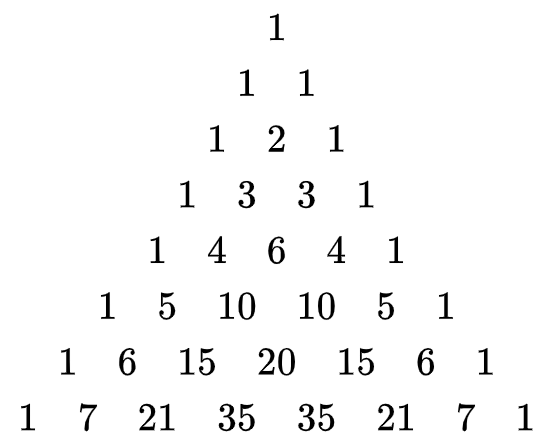The binomial theorem, also known as Newton’s theorem, is a relatively quick way to expand binomial expressions that are raised to a power. In this article, we will learn how to use the binomial theorem and we will look at some examples with answers to facilitate understanding.
In addition, we will also see a formula to calculate a specific term in a binomial expansion.
What is a binomial expression?
A binomial expression is an algebraic expression that contains two terms joined by an addition or subtraction sign. For example, (2+x) or (x-4) are examples of binomial expressions.
Many times these binomial expressions have exponents and we may need to fully expand them:
$latex {{(x+y)}^0}=1$
$latex {{(x+y)}^1}=x+y$
$latex {{(x+y)}^2}={{x}^2}+2xy+{{y}^2}$
$latex {{(x+y)}^3}={{x}^3}+3{{x}^2}y+3x{{y}^2}+{{y}^3}$
$${{(x+y)}^4}={{x}^4}+4{{x}^3}y+6{{x}^2}{{y}^2}+4x{{y}^3}+{{y}^4}$$
We can see that as the exponent gets larger, the expansion of these expressions becomes more tedious and this is not feasible for expressions with very large exponents.
Therefore, we are going to learn how to use the binomial theorem to expand binomial expressions without the need to multiply each of the terms individually.
What is the binomial theorem?
The binomial theorem tells us how to perform the algebraic expansion of exponents of a binomial. That is, the binomial theorem shows us how to expand a polynomial of the form $latex {{(a+b)}^n}$ to obtain all its terms.
For example, if we want to expand the expression $latex {{(2x+y)}^5}$, we would need to multiply the binomial $latex (2x+y)$ five times, which would take a long time. The binomial theorem allows us to take a shortcut by using a formula to expand this expression.
With the binomial theorem, it is possible to expand the power $latex {{(x + y)}^n}$ to form a sum of terms in the form $latex a{{x}^b}{{y}^c}$, where the exponents b and c are non-negative and add up to $latex b+c=n$. For example, consider the following expression:
$${{(x+y)}^4}={{x}^4}+4{{x}^3}y+6{{x}^2}{{y}^2}+4x{{y}^3}+{{y}^4}$$
The coefficient a in any term $latex a{{x}^b}{{y}^c}$ of the expanded version is known as the binomial coefficient. The binomial coefficient is also used in combinatorics, where we can get the number of different combinations of b elements that can be chosen from a set of n elements. This can also be written as $latex \left( {\begin{array}{*{20}{c}} n \\ b \end{array}} \right)$.
With the binomial theorem, we can expand any power of $latex (x+y)$ with a sum of the following form:
$${{\left( {x+y} \right)}^{n}}=\left( {\begin{array}{*{20}{c}} n \\ 0 \end{array}} \right){{x}^{n}}{{y}^{0}}+\left( {\begin{array}{*{20}{c}} n \\ 1 \end{array}} \right){{x}^{{n-1}}}{{y}^{1}} +\left( {\begin{array}{*{20}{c}} n \\ 2 \end{array}} \right){{x}^{{n-2}}}{{y}^{2}}+\ldots +\left( {\begin{array}{*{20}{c}} n \\ {n-1} \end{array}} \right){{x}^{1}}{{y}^{{n-1}}}+\left( {\begin{array}{*{20}{c}} n \\ n \end{array}} \right){{x}^{0}}{{y}^{n}}$$
Where each value $latex \left( {\begin{array}{*{20}{c}} n \\ k \end{array}} \right)$ is a positive integer known as the binomial coefficient.
Binomial theorem with Pascal’s triangle
An alternative to finding the coefficients of the terms in a binomial expansion is Pascal’s triangle. Pascal’s triangle is particularly useful for binomial expansions with small coefficients.

The rows in Pascal’s triangle are numbered starting with the row $latex n = 0$ at the top. In row 0, we have only the number 1. To construct the elements of the following rows, we add the two numbers that are above to form the new value.
When we don’t have numbers at the top, we replace them with zero. For example, each number in row 1 is $latex 0 + 1 = 1$.
How to use the binomial theorem?
To use the binomial theorem to expand a binomial of the form $latex {{(a+b)}^n}$, we need to remember the following:
- The exponents of the first term (a) decrease from n to zero.
- The exponents of the second term (b) increase from zero to n.
- The sum of the exponents of a and b in eache term equals n.
- The coefficients of the first and last term are both equal to 1.
Let’s use the binomial theorem to expand various expressions and understand the theorem:
EXAMPLE 1
Expand the binomial $latex {{(x+y)}^5}$ using Pascal’s triangle.
Solution: We can see that row 5 of Pascal’s triangle is 1, 5, 10, 10, 5, 1. Using these numbers for the binomial expansion, we have:
$${{(x+y)}^5}={{x}^5}+5{{x}^4}y+10{{x}^3}{{y}^2}+10{{x}^2}{{y}^3}+5x{{y}^4}+{{y}^5}$$
EXAMPLE 2
Expand the binomial $latex {{(x+y)}^4}$ using combinations.
Solution: This can be expanded as follows:
$latex =\left( {\begin{array}{*{20}{c}} 4 \\ 0 \end{array}} \right){{x}^{4}}+\left( {\begin{array}{*{20}{c}} 4 \\ 1 \end{array}} \right){{x}^{3}}y+\left( {\begin{array}{*{20}{c}} 4 \\ 2 \end{array}} \right){{x}^{2}}{{y}^{2}}$ $latex + \left( {\begin{array}{*{20}{c}} 4 \\ 3 \end{array}} \right)x{{y}^{3}}+\left( {\begin{array}{*{20}{c}} 4 \\ 4 \end{array}} \right){{y}^{4}}$
We remember that both $latex \left( {\begin{array}{*{20}{c}} 4 \\ 0 \end{array}} \right)$ and $latex \left( {\begin{array}{*{20}{c}} 4 \\ 4 \end{array}} \right)$ are equivalent to 1 since there is only one way to choose 0 and 4 elements from a set of 4 elements. So, we have:
$$={{x}^{4}}+\left( {\begin{array}{*{20}{c}} 4 \\ 1 \end{array}} \right){{x}^{3}}y+\left( {\begin{array}{*{20}{c}} 4 \\ 2 \end{array}} \right){{x}^{2}}{{y}^{2}}+\left( {\begin{array}{*{20}{c}} 4 \\ 3 \end{array}} \right)x{{y}^{3}}+{{y}^{4}}$$
Now, we evaluate each of the remaining combinatorics:
$latex \left( {\begin{array}{*{20}{c}} 4 \\ 1 \end{array}} \right)=\frac{{4!}}{{1!\left( {4-1} \right)!}}=\frac{{4!}}{{1!\left( 3 \right)!}}=4$
$latex \left( {\begin{array}{*{20}{c}} 4 \\ 2 \end{array}} \right)=\frac{{4!}}{{2!\left( {4-2} \right)!}}=\frac{{4!}}{{2!\left( 2 \right)!}}=6$
$latex \left( {\begin{array}{*{20}{c}} 4 \\ 3 \end{array}} \right)=\frac{{4!}}{{3!\left( {4-3} \right)!}}=\frac{{4!}}{{3!\left( 1 \right)!}}=4$
By substituting these numbers in the expression, we have:
$latex {{x}^4}+4{{x}^3}y+6{{x}^2}{{y}^2}+4x{{y}^3}+{{y}^4}$
How to calculate a specific term in Newton’s binomial?
There may be times when we want to identify a specific term in the expansion of $latex {{(x + y)}^ n}$. This is easy for the times when we have small n, but when we have binomials like $latex {{(x + y)}^9}$, this is more challenging.
Fortunately, we can use a formula for this. The term r of the binomial expansion can be found with the formula:
$latex \left( {\begin{array}{*{20}{c}} n \\ {r-1} \end{array}} \right){{a}^{{n-\left( {r-1} \right)}}}{{b}^{{r-1}}}$
EXAMPLE
Find the fifth term of $latex {{(3x-4)}^{{12}}}$.
Solution: Here, we have $latex n=12$. We use $latex r=5$ because we are looking for the fifth term. Using the formula with these values, we have:
$latex \left( {\begin{array}{*{20}{c}} 12 \\ {5-1} \end{array}} \right){{3x}^{{12-\left( {5-1} \right)}}}{{(-4)}^{{5-1}}}$
$latex \left( {\begin{array}{*{20}{c}} {12} \\ 4 \end{array}} \right){{\left( {3x} \right)}^{8}}{{\left( {-4} \right)}^{4}}$
We can find the value of $latex \left( {\begin{array}{*{20}{c}} {12} \\ 4 \end{array}} \right)$ using the combinations formula:
$latex \frac{{n!}}{{\left( {n-k} \right)!k!}}=\frac{{12!}}{{\left( {12-4} \right)!4!}}$
$latex =495$
Therefore, we have:
$latex 495{{(3x)}^8}{{(-4)}^4}$
By expanding this fully, we have:
$latex 831409920{{x}^8}$
See also
Interested in learning more about algebraic expressions and factoring? Take a look at these pages:




